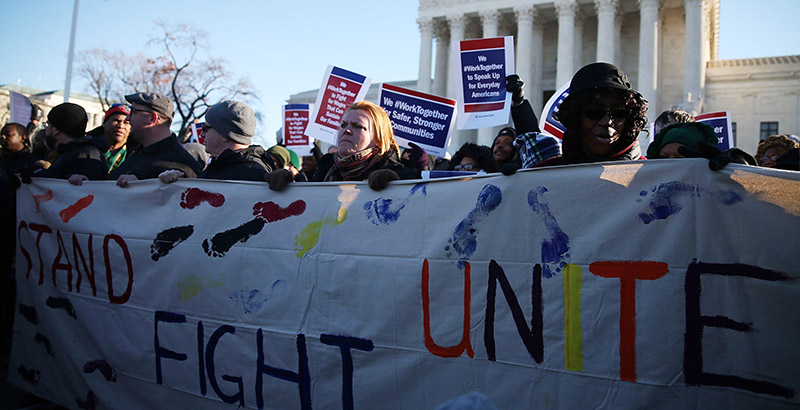Janus, We Hardly Knew You: Rank-and-File Union Members Remain in the Dark About a Pivotal Dues Case Headed to the Supreme Court

New York City
Last September, union President Michael Mulgrew sent a letter to his members that included a warning and a reminder.
“The Janus case is paid for and brought to us by people who want to destroy unions so your benefits and rights can be taken away,” wrote the United Federation of Teachers chief, referring to the Supreme Court–bound challenge to mandatory dues. “As we brace for this challenge ahead, remember that all of us together are the union. Because we have stuck together, we have pensions, employer-paid health insurance, job security, due-process rights, a grievance process and a voice in how our schools are run.”
Mulgrew’s audience presumably values its benefits. But past patterns in union activism — as well as recent anecdotal reports — suggest that even after months of outreach and despite its potential implications, a surprisingly large number of teachers aren’t familiar with Janus v. AFSCME. The case, brought by an Illinois child welfare worker, challenges the constitutionality of agency fees — what unions charge non-members for their share of collective bargaining costs — on the basis of free speech.
The awareness level is likely to get a bump in coming weeks as the UFT works to consolidate support in a crescendo of protest leading up to oral arguments on February 26. But so far anxiety about a threat Mulgrew has called the UFT’s “number one issue,” and for which the leadership has been preparing since an earlier high court challenge in 2015, apparently hasn’t seeped far into schools.
“No one is asking about it,” said a UFT chapter leader who supports the union’s position but asked for anonymity to avoid reprisals for speaking publicly. He said his school’s faculty was typically more engaged than many others but had little understanding of the case.
“Most of them have heard of it. Period,” he said, citing the limits of his co-workers’ familiarity with the case.
WATCH — EVERYTHING YOU NEED TO KNOW ABOUT THE JANUS UNION CASE IN 105 SECONDS:
The union has planned rallies, canvassed door-to-door, and paid staff to distribute leaflets. The effectiveness of these endeavors was called into question by Arthur Goldstein, a technology teacher and the chapter leader at Francis Lewis High School in Queens, who recounted a funny and odd exchange between what appeared to be a teacher at his school and a UFT rep.
The rep knocked on the teacher’s door at home, Goldstein wrote in December on his blog, NYC Educator. “The person at the door knew her name and said he was from the UFT. She was pretty surprised by this. He said he wanted to talk to her about Janice. She said she didn’t know who Janice was. Then he said no, it’s Janus, not Janice, and it’s a what, not a who. So she said she didn’t know what Janus was either. The guy said OK, and then he left,” Goldstein wrote.
“This guy, whoever he was, went for a weekend of training, and when somebody says she doesn’t know what Janus is, he doesn’t even bother to tell her. Is that why we’re sending people out knocking on doors?”
UFT officials say large-scale organizing initiatives have been in place since the union joined a far-flung coalition to prevent a potential overhaul of state government that they feared could erode pension benefits. The measure was soundly rejected by New York voters in November.
“Building on the successful campaign to defeat the Constitutional Convention, we are doing outreach to our members about the Janus case,” said UFT spokeswoman Alison Gendar. “We are finding that many educators already understand the danger the case poses to wages and benefits and to their ability to have a say in what happens in their schools and classrooms.”
Building rank-and-file support is critical to stemming attrition should the court reach a decision unfavorable to public sector unions. Nearly all legal observers believe the justices will side with Janus, who says agency fees are used to support his union’s political aims, thereby curtailing his First Amendment rights. A 2016 case, Friedrichs v. California Teachers Association, appeared to be headed to a decision ending mandatory dues until potential swing Justice Antonin Scalia died, deadlocking the justices at 4–4.
Mike Antonucci, a longtime union observer and regular contributor to The 74, reported that the California Teachers Association warned of an initial 30 to 40 percent drop in membership in the event of an unfavorable decision. The CTA’s parent union, the National Teachers Association, has budgeted for the loss of 20,000 members, while the UFT predicts a 20 percent reduction in its roughly 200,000 members, which include retirees.
The conservative Empire Center for Public Policy calculated that New York unions collected $862 million in dues and fees. Based on the number who opt out of union membership but still pay agency fees, the unions would lose $110 million in the first year. Depending on how many current members disaffiliated, the actual loss could be far higher.
In addition to stemming losses, union protests are also geared to making changes in state law, according to Daniel DiSalvo, a political scientist at City College of New York who has criticized public-employee unions. Acknowledging the unions’ “massive effort to reinvigorate relations with their members,” he argues that labor leaders hope as well to more deeply embed policies like automatic enrollment of new workers and provisions that establish unions as having exclusive bargaining power in school districts.
Even with the stakes so high, only a fraction of workers are likely to participate in activity to protect their unions. A 2016 Massachusetts proposal to create more charter schools was fiercely — and successfully — opposed by the state teachers union. Although more than $40 million was spent by the two sides, only 1 percent of members took part in union protests. An internal memo said: “While this percentage was higher than in previous campaigns, it felt low to many.”
In a 2005 internal survey by NEA, the country’s largest union, a total of 36 percent — 972,000 members — responded “not at all” to a question asking how involved they were in the union. Among members with three or fewer years of affiliation, the figure rose to 48 percent.
When the teacher-based reform group Educators for Excellence polled its members about the Friedrichs case in December 2015, a few weeks before it was heard by the Supreme Court, just 17 percent said they were aware of it.
“There was an issue around dues a while ago that no one understood,” the UFT chapter leader recalled. “I would say understanding of Janus is a little bit higher. A little.”
Get stories like these delivered straight to your inbox. Sign up for The 74 Newsletter

;)
